#life in ancient rome
Text

314 notes
·
View notes
Photo
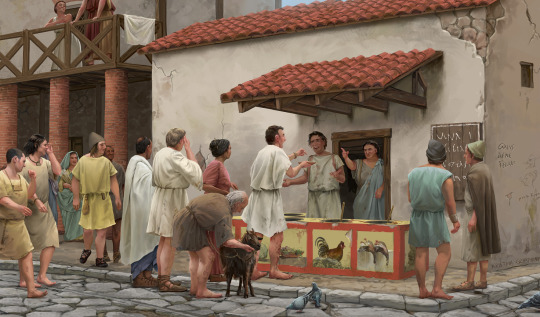
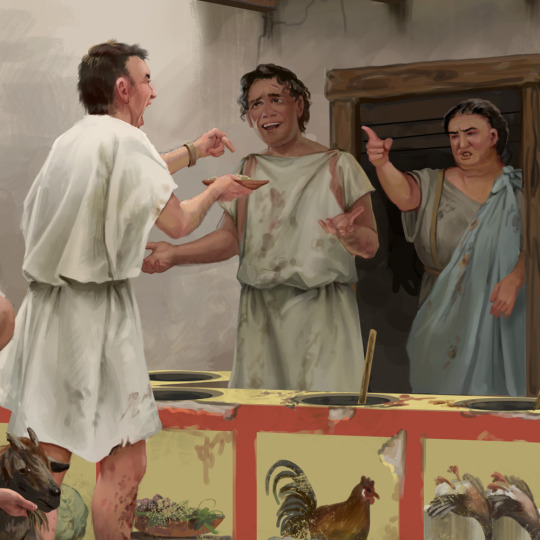
Uh-oh, someone's not happy with his order at the thermopolium!
Inspired by recent discoveries in Pompeii, I've since wanted to draw a "snapshot" of a street with people in ancient Rome.
Medium: Photoshop & Wacom Intuos.
Print available here
#ancient rome#roman#rome#pompeii#romans#slice of life#streetlife#ancient history#history#history art#histoire
3K notes
·
View notes
Text



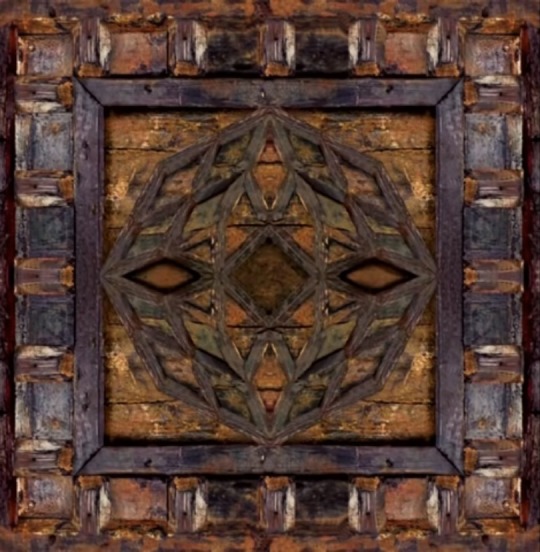

Wooden ceiling panels from Herculaneum with restored colour.
The painted surfaces were preserved enough when these panels were discovered that they were able to identify the colours using scientific analysis.
Stills from this documentary.
552 notes
·
View notes
Text
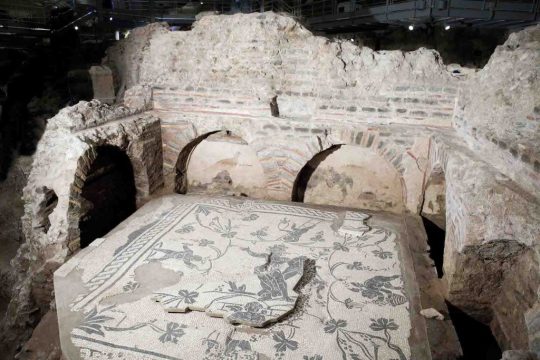
Vatican Museums Opens Ancient Roman Necropolis to the Public
The site was previously only accessible to scholars and specialists.
The Vatican Museums has newly opened to the public an ancient necropolis stocked with carved marble sarcophagi and bone-filled open graves of everyday ancient Romans.
The word necropolis comes from the Greek expression for “city of the dead.” These “cities” grew up alongside roads outside the urban center due to laws forbidding cremation and burial of the dead inside city limits. Funerary practices and rites are preserved especially clearly in the necropolis that extends along the Via Triumphalis (a Roman road now known as the Via Trionfale), with burial sites accompanied by eye-popping Roman frescoes and mosaics.
Previously, the necropolis was accessible only to certain groups of scholars and specialists. It is now open to the public via the new Saint Rose Gate entrance, inaugurated with the exhibition “Life and Death in the Rome of the Caesars.”
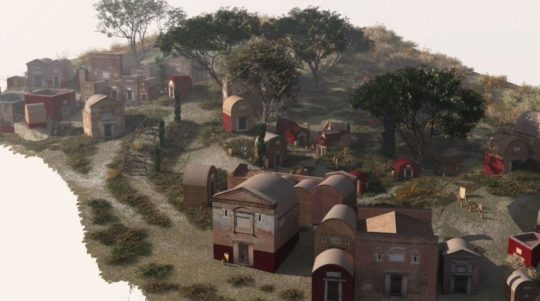
How extensive is the archaeological area?
It extends nearly 11,000 square feet. The size of the necropolis is not as extensive as some other Roman burial sites, but its importance lies in its proximity to one of the most significant religious sites in Christianity.
What is known about particular people who are buried there?
According to archaeologists, no less than the tomb of St. Peter himself is located in the Vatican Necropolis.
But in general, “Here, we have represented the lower middle class of Rome’s population,” said Leonardo Di Blasi, an archaeologist with the Vatican Museums, in a video on Euro News. “They are essentially slaves, freedmen, artisans of the city of Rome.” Some were the property of the emperor, and are indicated to have been the “servant of Nero.”
One of them was a man named Alcimus, who was the set director for the downtown Theater of Pompeii, the most important theater of the period. Another was a horse trainer who worked at the chariot races.
One young boy is interred there, according to the Catholic News Service, marked by a sculpture of a boy’s head accompanied by an inscription reading “Vixit Anni IIII Menses IIII Dies X,” Latin for “He lived four years, four months, and 10 days.”
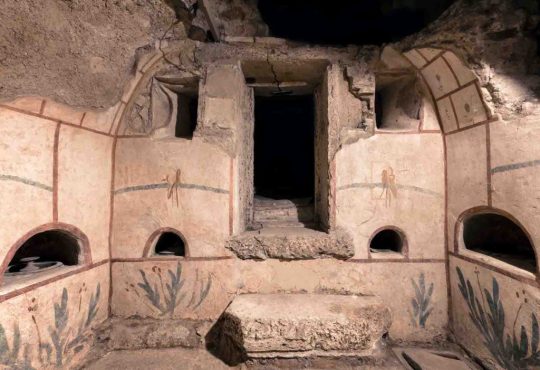
How did this ancient burial ground come to light?
The Vatican burial grounds were first explored in the 1940s at the request of then Pope Pius X, who wanted to be buried near the grave of Peter the Apostle. The dig revealed numerous mausoleums and tombs.
The newest part of the burial ground was revealed through an infrastructure project in 2003, as the Vatican excavated for a new multilevel employee parking garage.
What happened when the Vatican discovered these newest burial grounds?
The department of the Vatican that was overseeing construction of the parking garage, intent on meeting its deadline, was accused of trying to conceal the find, Giandomenico Spinola, an archaeologist and deputy artistic-scientific director of the museums, told the Catholic News Service. It was only when journalists publicized the discovery that he and his colleagues were invited in to advise.
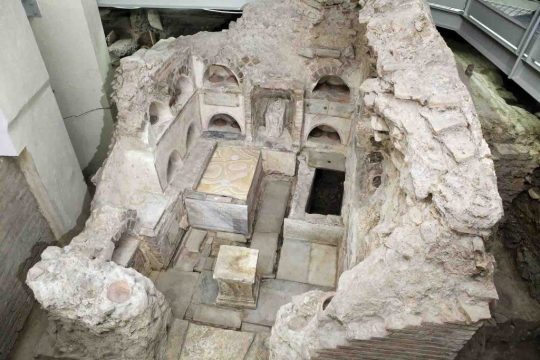

When were the bodies there buried? How have the tombs been so well preserved?
Bodies were interred in this burial ground between the first century B.C.E and the fourth century C.E., and organic remains have vanished. A number of the graves, including their tombs and decorations, including frescoes, mosaic floors, and marble-carved inscriptions, were fortuitously preserved by a series of mudslides in the area.
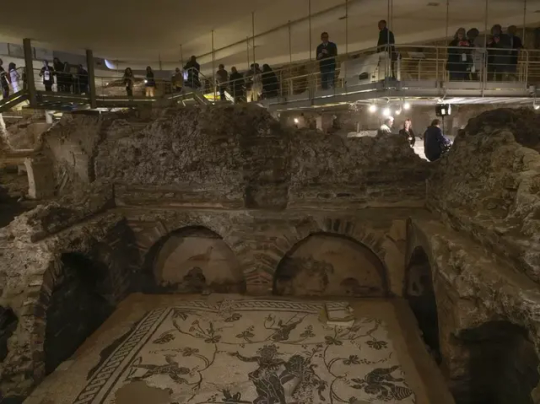
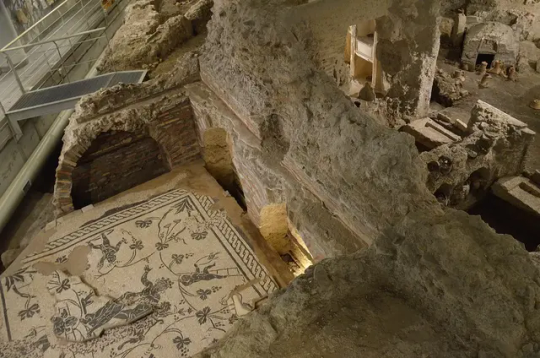
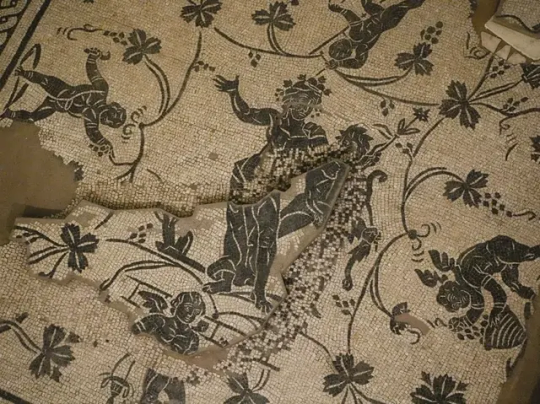
#Vatican Museums Opens Ancient Roman Necropolis to the Public#The Vatican Museums#Ancient Roman 'City for the Dead'#Via Triumphalis necropolis#Life and Death in the Rome of the Caesars#ancient graves#ancient tombs#ancient necropolis#ancient artifacts#archeology#archeolgst#history#history news#ancient history#ancient culture#ancient civilizations#ancient rome#roman history#roman empire#roman art
268 notes
·
View notes
Text
i think a lot about how the roman thermae and bathing culture is presented as a sign of how Civilized and Advanced the romans were but one of the essential parts of the thermae was the caldarium, essentially a sauna, which was heated up through the floor.... under which slaves constantly had to toil to feed the fire while suffocating in the heat and steam that would rise through the floor to make free romans and the slaves' masters get a nice sweat, free to move on to the cold baths in the next room whenever they wanted.
#'roman citizenship was given to every free man in the empire' sure! but not only was that very late#but a very considerable portion of the population of the empire at any given point was a slave. most slaves lived horrific lives.#i mean i want to be clear rome wasn't like EXCEPTIONALLY brutal or bad to slaves compared to its neighbours#by which i mean that it was just as callous as most ancient mediterranean civilizations when it came to the treatment of slaves#and the scale of roman's brutality towards slaves matches the scale of its size and timeframe.#athenians were a much smaller population of the ancient world but slaves in the silver mines of laureion had a life expectancy of five year#that's still thousands upon thousands of people who suffered horrific deaths and lived the rest of their lives in miserable conditions#all to make the city rich#anyhow i don't think rome is like a particularly evil empire in the sense that all empires are evil#people love to imagine themselves ancient roman aristocrats but you would not have been one. you would be lucky to be a /domestic/ slave.#who still had shit lives tbc but exponentially better than working on the latifundiae#eli talks
107 notes
·
View notes
Text

Carbonized money purse found in Herculaneum.
Because wood is perishable, items like this were not preserved in the archeological record and it is only through excavations in Pompeii and Herculaneum that we know these existed at all.
#ancient rome#roman empire#ancient culture#ancient civilisations#daily life in history#herculaneum#mt vesuvius
373 notes
·
View notes
Text
imagine this: you're the baddest bitch in the Roman Republic. you have spent the past few decades fighting, fucking and planning to take control of the known world. you've killed millions of people. you became the fucking pontifex maximus and used some guy's idea to reinvent the calendar. you were the first roman to have a terrible vacation experience in the UK. you won a civil war. your best friend likes to commission naked statues of you and stand in front of them calling you a king at parties.
it's the 15th March 44 b.c.e and life is good. the people love you and you just became a dictator for life. you leave your mansion, ignoring your wife's pleas for you to stay (venus above that woman is in love with you) and shake off the soothsayer who keeps following you around and talking about your doom (spurinna is obsessed with you). you swagger into work, sit down, and are immediately stabbed by a bunch of your coworkers. you stagger around for a bit feeling sorry for yourself, before collapsing down dead at the statue of the guy that you had that civil war against. what a way to go.
#can you imagine?#all that work just to be stabbed by a bunch of wannabe revolutionaries#wearing togas#only for the guy after you to just use all of that power you created anyways?#kind of embarrassing ngl#ides of march#julius caesar#caesar#et tu brutus?#ancient rome#gaius julius caesar#gaius cassius longinus#marcus junius brutus#marcus antonius#spurinna#calpurnia#plutarch#life of caesar#classics#titus livius#tacitus#pompey the great
700 notes
·
View notes
Text


Palazzo Massimo, Roma
#affresco#ancient rome#ancient art#roman empire#Art#sea life#octopus#Shrimp#roman art#fresco painting#italy
37 notes
·
View notes
Text

Pantheon and the moon
Rome, Italy
January, 2023
@bioluminescencia
#ancient rome#italy#europe#original photographers#travel photo blog#photographers on tumblr#photooftheday#history#museum#geography#moonlight#view#moon#moodboard#landscape#monochrome#photography#dark grunge#dark academia#cottage aesthetic#cats of tumblr#bookworm#knowledge#romantizing life#lifestyle#amazing#scenery#goddess#culture#street photography
19 notes
·
View notes
Text


@nadziejaestel
#antique beauty#antique#ancient history#ancient greece#ancient rome#the secret history#hermitage#dark academia moodboard#dark academism#dark akademia#dark academia#dead poets society#light acamedia#light academia moodboard#light academia aesthetic#light academia#moodboard aesthetic#vintage moodboard#moodboard#русский блог#русский тамблер#турумбочка#photography#soft life#lifestyle#saint petersburg#vintage#museum#history#ancient art
28 notes
·
View notes
Text

Sculpture of baby Hercules catching the snake - Sculpture In Marble of the second half of 2nd century - Capitoline museum, Rome
#philosophy#sculpture#architecture#renaissance#italy#rome#19th century#academia#art history#italian art#ancient sculpture#ancient#dark academia#roman empire#empire#roman history#history#philosophy of life#masterpiece#roman sculpture#ancient roman sculpture
23 notes
·
View notes
Text


@pin4tre DREW THIS FOR ME!!! <3333
#hetalia#aph germania#aph hetalia#aph ancients#gerrome#hws roman empire#hws germania#aph ancient rome#i love them sm!!!!#GAY OLD MEN YAOI!!!!!#ping my life is yours
17 notes
·
View notes
Text

Roman Over Life-Size Statue of Antinous, Companion of Emperor Hadrian, as a Hunter
130-138 AD
Nude but for the paludamentun (cloak) over his left shoulder and arm, clasped on his right shoulder. He has the characteristic muscular development of Antinous, his boyish face, and mass of curls bound with a diadem.
Limestone.
H. 152 x w. 51 x d. 31.5 cm.
Antinous, also called Antinoös, (c. 111 – c. 130) was a Greek youth from Bithynia and a favourite and lover of the Roman emperor Hadrian. Following his premature death before his twentieth birthday, Antinous was deified on Hadrian's orders, being worshipped in both the Greek East and Latin West, sometimes as a god (θεός, theós) and sometimes merely as a hero (ἥρως, hḗrōs).
Little is known of Antinous's life, although it is known that he was born in Claudiopolis (present day Bolu, Turkey), in the Roman province of Bithynia et Pontus. He was probably introduced to Hadrian in 123, before being taken to Italy for a higher education. He had become the favourite of Hadrian by 128, when he was taken on a tour of the Roman Empire as part of Hadrian's personal retinue. Antinous accompanied Hadrian during his attendance of the annual Eleusinian Mysteries in Athens, and was with him when he killed the Marousian lion in Libya, an event highly publicised by the Emperor. In October 130, as they were part of a flotilla going along the Nile, Antinous died amid mysterious circumstances. Various suggestions have been put forward for how he died, ranging from an accidental drowning to an intentional human sacrifice or suicide.
Following his death, Hadrian deified Antinous and founded an organised cult devoted to his worship that spread throughout the Empire. Hadrian founded the city of Antinoöpolis close to Antinous's place of death, which became a cultic centre for the worship of Osiris-Antinous. Hadrian also founded games in commemoration of Antinous to take place in both Antinoöpolis and Athens, with Antinous becoming a symbol of Hadrian's dreams of pan-Hellenism. The worship of Antinous proved to be one of the most enduring and popular of cults of deified humans in the Roman empire, and events continued to be founded in his honour long after Hadrian's death.
#Emperor Hadriian#Roman Over Life-Size Statue of Antinous#limestone#limestone statue#ancient artifacts#archaeology#archeolgst#history#history news#ancient history#ancient culture#ancient civilizations#ancient rome#roman history#roman empire#roman art
95 notes
·
View notes
Text
“I think, therefore I am”




Go live your dream… work for it then achieve it.
#italy#made in italy#vanilla#christianity#nature#ancient rome#philosophy#philanthropy#thoughts#my thougts#lovely#fountain#beauty#love#love poem#Descartes#soul#sky#water#perfume#rome#good life#motivation#motivating quotes#studyblr#studying#ethical lifestyle#lifestyle#student life#life
11 notes
·
View notes
Text

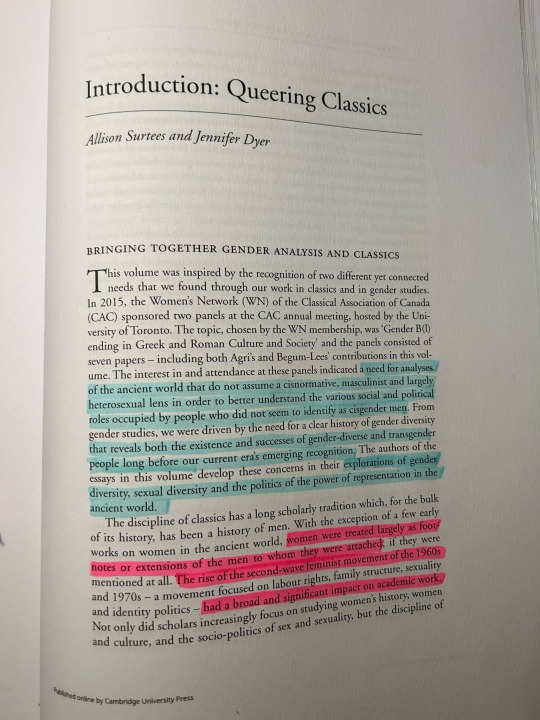
as a queer person, learning about queerness in antiquity means so much to me. we even discussed queer, feminist and trans theory in my lecture 🫶🏻 its so important that we keep researching and studying antique works with new eyes, so we dont base all of our trust on the analyses written in 1700-1800s (which were most likely bigoted in some way!). we’re a lot of queer students in my class so it really made an impact🏛️
#roman empire#bookblr#studyblr#ancient rome#classics#dark academia#light academia#studying#art history#art history student#studyspo#study#study motivation#student life#college life#study aesthetic#university#100 days of productivity
63 notes
·
View notes
Text
keeping up with re: dracula and cry havoc at the same time really is the duality of beth eyre
#incorporating into my belief system that lucy westenra has a lot of vivid dreams about living in ancient rome fucking cleopatra#re: dracula#cry havoc#marina marvels at life
68 notes
·
View notes